A
Auto Express
Guest
The Mazda MX-30 represents the Japanese manufacturer’s first toe in the water of the electric car market, but even in a sector that’s increasingly teeming with rivals, this small SUV has no trouble standing out.
Sharp, stylish design, unusual rear-hinged doors, an engaging driving experience and a top class safety score are the big selling points, but the limited range and poor rear passenger accommodation will deter many. Think of the MX-30 as a fun, fashionable city car, or second car, and it makes sense. As a small SUV for families, it’s a much tougher sell.
True to form, Mazda has steadfastly avoided doing things by the book with its first pure electric car. The MX-30 uses the firm’s own e-Skyactiv electric drive system and a modest 35.5kWh lithium-ion battery for a range of just 124 miles.
The rear-hinged rear doors that hark back to Mazda’s own RX-8 coupe create a pillarless cabin that’s a novel proposition in the modern small car segment, while on the inside, the car’s green credentials are underlined by unusual environmentally-friendly material choices. The vision for the MX-30, as tends to be the way with Mazda products, feels cohesive but will it be one that enough customers will share?
The MX-30 slots into the Mazda range as an electric alternative to its CX-30 sister car. Both small SUVs are broadly the same size, but the MX-30 swaps the traditional five-door layout for that unorthodox pillarless cabin and a coupe-like roofline that tapers down to the rear. The pair occupy the level below the CX-5 mid-sized SUV in Mazda’s range.
In terms of rivals, the MX-30 theoretically goes up against other small electric SUVs like the Kia Soul EV, Vauxhall Mokka-e and Hyundai Kona Electric. However, these cars employ larger batteries that help them significantly outstrip the MX-30 in terms of range and push them upwards in terms of price.
The MX-30 can be yours for just over £26,000, once the Plug-in Car Grant (PiCG) has done its work, so it’s around £3,000 more than a petrol powered CX-30 but upwards of £4,000 less than many of the obvious electric SUV alternatives.
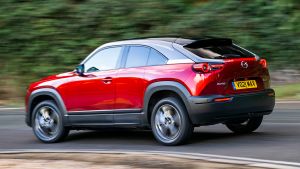
Mazda MX-30 - rear action
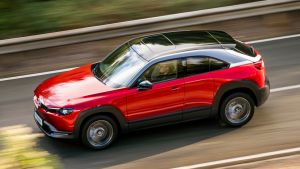
Mazda MX-30 - front above

Mazda MX-30 - front
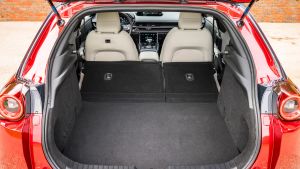
Mazda MX-30 - boot seats down
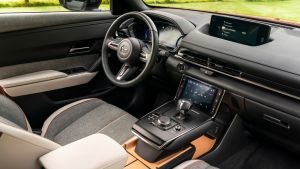
Mazda MX-30 - cabin
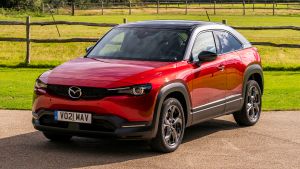
Mazda MX-30 - front static
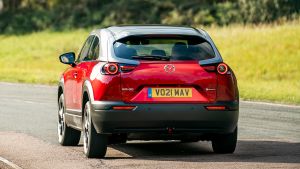
Mazda MX-30 - rear cornering
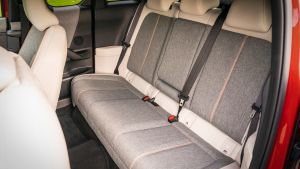
Mazda MX-30 - rear seats
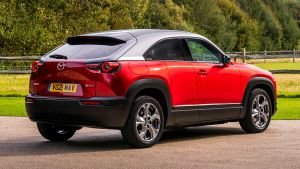
Mazda MX-30 - rear static
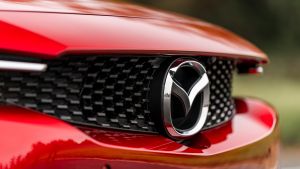
Mazda MX-30 - grile
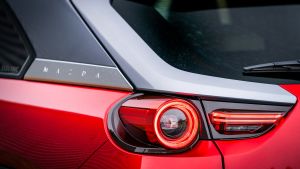
Mazda MX-30 - rear light
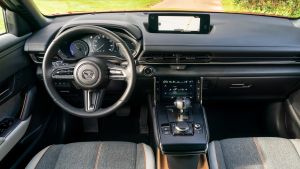
Mazda MX-30 - dash
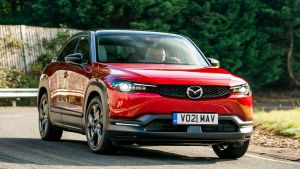
Mazda MX-30 - front tracking
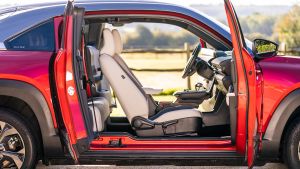
Mazda MX-30 - front seats
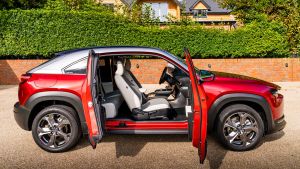
Mazda MX-30 - doors
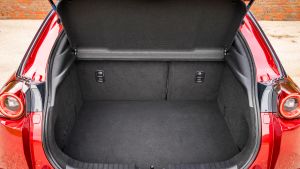
Mazda MX-30 - boot

Mazda MX-30 - cork
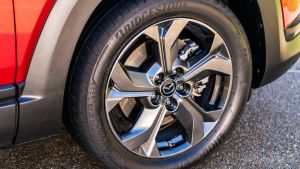
Mazda MX-30 - wheel
With its crisp styling, in line with the Mazda ‘Kodo’ design philosophy, innovative material choices and unusual layout, it’s a car that could easily be seen as an alternative to trendy electric city cars like the Honda E, MINI Electric or the new Fiat 500. On price and range these cars are closer to the Mazda than the market’s SUV contingent. In addition, Mazda has built its electric offering around its ‘Jinba Ittai’ ethos to deliver swift reactions to driver inputs and the MX-30 is certainly a more sprightly drive than your average electric SUV.
With one electric power choice, a single battery size and a simple trim level hierarchy, choosing your MX-30 shouldn’t be too taxing. SE-L Lux, Sport Lux and GT Sport Tech trim levels make up the core range, but a limited-run First Edition variant was also made available from launch.
All models get LED headlamps, heated electric folding mirrors, parking sensors at both ends, a reversing camera and rain-sensing wipers. There’s an 8.8” screen for the infotainment, and standard Apple CarPlay and Android Auto integrations, controlled by a central rotary knob and panel of buttons.
All cars have Mazda’s G-Vectoring Control Plus which distributes the electric motor’s torque to optimise grip and stability. Plus there’s Mazda’s Connected Services with the MyMazda app bringing remote control over vehicle functions and relaying charging information back to your phone.
Continue reading...
Sharp, stylish design, unusual rear-hinged doors, an engaging driving experience and a top class safety score are the big selling points, but the limited range and poor rear passenger accommodation will deter many. Think of the MX-30 as a fun, fashionable city car, or second car, and it makes sense. As a small SUV for families, it’s a much tougher sell.
About the Mazda MX-30
True to form, Mazda has steadfastly avoided doing things by the book with its first pure electric car. The MX-30 uses the firm’s own e-Skyactiv electric drive system and a modest 35.5kWh lithium-ion battery for a range of just 124 miles.
The rear-hinged rear doors that hark back to Mazda’s own RX-8 coupe create a pillarless cabin that’s a novel proposition in the modern small car segment, while on the inside, the car’s green credentials are underlined by unusual environmentally-friendly material choices. The vision for the MX-30, as tends to be the way with Mazda products, feels cohesive but will it be one that enough customers will share?
- SEE MORE Best electric cars to buy 2021
The MX-30 slots into the Mazda range as an electric alternative to its CX-30 sister car. Both small SUVs are broadly the same size, but the MX-30 swaps the traditional five-door layout for that unorthodox pillarless cabin and a coupe-like roofline that tapers down to the rear. The pair occupy the level below the CX-5 mid-sized SUV in Mazda’s range.
In terms of rivals, the MX-30 theoretically goes up against other small electric SUVs like the Kia Soul EV, Vauxhall Mokka-e and Hyundai Kona Electric. However, these cars employ larger batteries that help them significantly outstrip the MX-30 in terms of range and push them upwards in terms of price.
The MX-30 can be yours for just over £26,000, once the Plug-in Car Grant (PiCG) has done its work, so it’s around £3,000 more than a petrol powered CX-30 but upwards of £4,000 less than many of the obvious electric SUV alternatives.

Mazda MX-30 - rear action

Mazda MX-30 - front above

Mazda MX-30 - front

Mazda MX-30 - boot seats down

Mazda MX-30 - cabin

Mazda MX-30 - front static

Mazda MX-30 - rear cornering

Mazda MX-30 - rear seats

Mazda MX-30 - rear static

Mazda MX-30 - grile

Mazda MX-30 - rear light

Mazda MX-30 - dash

Mazda MX-30 - front tracking

Mazda MX-30 - front seats

Mazda MX-30 - doors

Mazda MX-30 - boot

Mazda MX-30 - cork

Mazda MX-30 - wheel
With its crisp styling, in line with the Mazda ‘Kodo’ design philosophy, innovative material choices and unusual layout, it’s a car that could easily be seen as an alternative to trendy electric city cars like the Honda E, MINI Electric or the new Fiat 500. On price and range these cars are closer to the Mazda than the market’s SUV contingent. In addition, Mazda has built its electric offering around its ‘Jinba Ittai’ ethos to deliver swift reactions to driver inputs and the MX-30 is certainly a more sprightly drive than your average electric SUV.
With one electric power choice, a single battery size and a simple trim level hierarchy, choosing your MX-30 shouldn’t be too taxing. SE-L Lux, Sport Lux and GT Sport Tech trim levels make up the core range, but a limited-run First Edition variant was also made available from launch.
All models get LED headlamps, heated electric folding mirrors, parking sensors at both ends, a reversing camera and rain-sensing wipers. There’s an 8.8” screen for the infotainment, and standard Apple CarPlay and Android Auto integrations, controlled by a central rotary knob and panel of buttons.
All cars have Mazda’s G-Vectoring Control Plus which distributes the electric motor’s torque to optimise grip and stability. Plus there’s Mazda’s Connected Services with the MyMazda app bringing remote control over vehicle functions and relaying charging information back to your phone.
Continue reading...
